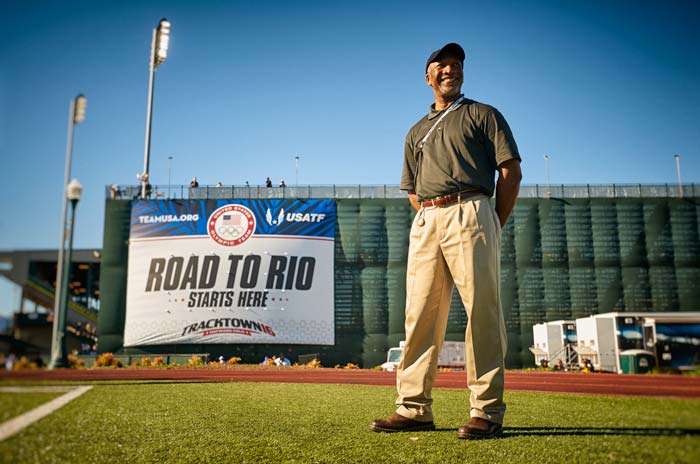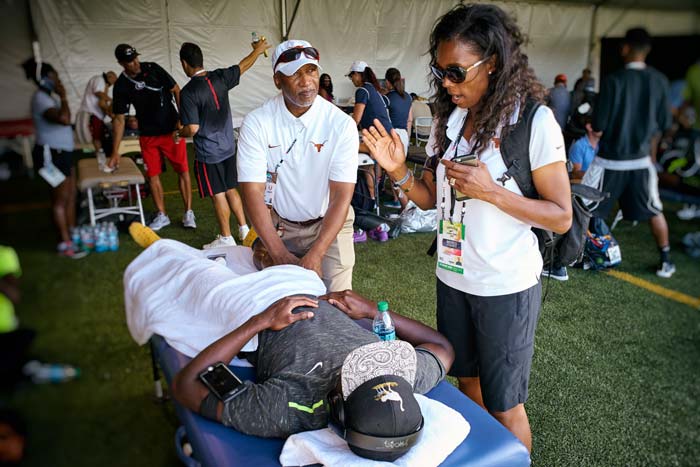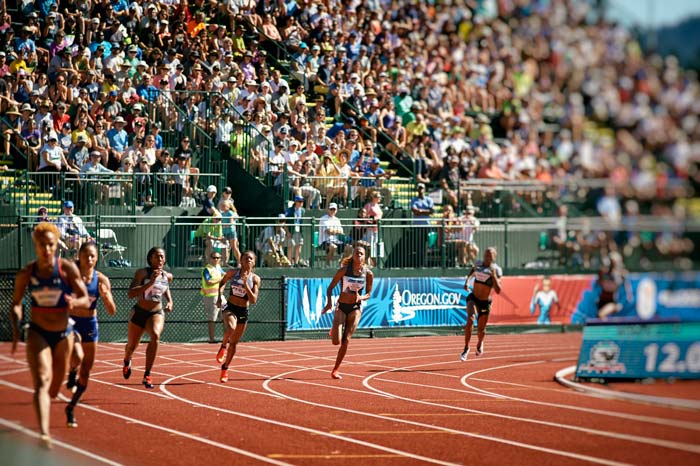Last Updated on February 26, 2025 by MASSAGE Magazine

Sports massage pioneer Benny Vaughn at Hayward Field at the University of Oregon in Eugene, where he provided massage therapy to athletes competing at the 2016 Olympic Track and Field Trials. | Photos by Dave Shafer
Many of the athletes competing at the 2016 Olympic Games taking place now in Rio de Janeiro, Brazil, are big-time fans of bodywork.
Consider the coverage of Olympic athlete Bralon Taplin, a 400-meter runner from Grenada, shown using the tapping technique called Emotional Freedom Technique before competing.
And then there are the images of Michael Phelps rising from the water, and the massage-cupping rings on his back and shoulders that have brought new attention to the cupping bodywork modality—just as volleyball players crisscrossed with kinesiology tape first drew international attention to taping at the 2012 Summer Olympic Games in London, England.
Top athletes adopt the health practices that will help them prepare for an event, recover from injury and compete at the best of their ability. This means they embrace established and emerging massage and bodywork techniques, oftentimes before the general public does.
Olympic athletes have utilized established massage techniques, including Swedish massage, handheld tools, neuromuscular and trigger-point therapy, Rolfing Structural Integration and sports massage, as well, and have for decades.
In fact, it’s been 20 years since massage became an official component of athlete care, at the 1996 Summer Olympic Games in Atlanta, Georgia.
The photos running with this article document work by Benny Vaughn, A.T.C., L.M.T., C.S.C.S., at the 2016 Olympic Track and Field Trials, held at the University of Oregon, at Eugene.
Pro Sports Advances Massage
What follows here is a first-person account of providing soft tissue work to athletes, and how that work has evolved in the world of professional sports, from soft-tissue therapist Richard Lomeli, C.M.T., whose clientele consists of professional athletes.
Lomeli was a massage therapist on the Los Angeles Kings professional hockey team’s training staff for the 2014-2015 season, and has worked with NFL and track-and-field athletes, and professional triathletes competing around the world.
“Advancements in the approach to training, conditioning and nutrition [have] definitely played a heavy role in the increase of athletic performance over the years,” Lomeli said. “It almost seems like we can expect to see new records made during the Olympics.
“With consistent advancements in training to increase performance and the need of accelerated recovery, it has been necessary for soft-tissue therapy to go through a consistent evolution to effectively keep up with that demand.”

Benny Vaughn provides sports massage to 200- and 400-meter athlete Aldrich Bailey, Jr., as Associate Head Coach of the University of Texas Tonja Buford-Bailey gives a debriefing to her athlete.
The Modern-Day Reality
“In the past, a typical massage session in a pro sports training room would either be a pre-event warm-up, or a post-event cool-down flush to move things along,” Lomeli continued. “A variation of these pre-and-post techniques including the use of effleurage, petrissage and even tapotement were commonly used to address a specific issue an athlete complained about.
“Today, an athlete will hobble to his or her sports massage therapist during a game complaining of a specific pain or issue inhibiting performance. In that situation, you don’t have time to remove their jersey and equipment so that you can apply lotion and warm up their tissue for five, 10 or 15 minutes.
“The modern day game-time reality is that you may only have two to five minutes to quickly gather information, assess and treat. Twenty to 30 years ago, this situation was not much of an expectation; however, in today’s world of professional sports, during competition an athlete is depending on you as a soft-tissue therapist to do just that.
“Manual therapy modalities like neuromuscular and trigger-point therapy combined with fascial manipulation tools and techniques are heavily used by top athletes. Functional movement assessments to identify faulty motor patterns and trigger point referred pain to help locate dysfunctional tissue(s) are skills that create a laser-guided approach when designing a treatment that is both effective and efficient.
“The implementation of scraping tools to free up restricted fascia to increase joint mobility can do in seconds what took minutes in the past. Trigger points, once upon a time, created a puzzle wrapped in an enigma stuck in a nightmare for athletes and their trainers.
“Today, a trigger point can be quickly identified, located and released between a few seconds to a couple of minutes, drastically decreasing pain and improving mobility.”

The 400-meter women’s final. In the middle is 400-meter athlete Courtney Okolo, one of the athletes who was part of the team that Benny Vaughn provided sports massage therapy to.
Olympic Athletes to Come
“I have always felt that the progression of soft-tissue therapy in professional sports has greatly contributed to the advancement of the massage therapy profession as a whole—similar to how cutting-edge race car technology eventually makes its way to the family sedan to increase safety,” said Lomeli. “It’s exciting to think about where soft-tissue therapy will be in the next 20 to 30 years.”
It is also exciting to consider that more massage and bodywork techniques could be highlighted on the international stage at the 2018 Winter Olympic Games in PyeongChang, Republic of Korea, and the 2020 Summer Olympic Games in Tokyo, Japan.
About the Author
Richard Lomeli, C.M.T., is a soft-tissue therapist whose primary clientele consists of professional athletes who perform at the highest levels of competition. He was a massage therapist on the Los Angeles Kings professional hockey team’s training staff for the 2014-2015 season, and has worked with NFL and track-and-field athletes, and professional triathletes competing around the world.
About the Photographer
Dave Shafer is from the small town of Rochester, Pennsylvania. In this small town he found his two loves: baseball and photography. After baseball ran its course, it’s been 20-plus years of being a people-and-environment photographer that keeps the fire burning bright. Today, Shafer makes his home in Texas with his wife—and he can still be found hitting baseballs in the batting cages from time to time.